
How to choose the perfect size ceiling light for any room
Search
Things to consider when sizing a light fixture
- Will the light be over some furniture? - Are people going to be walking underneath it?
- How tall are your ceilings, and how much clearance or head-room will you need below the light fixture?
- What kind of light fixture will fit within the amount of clearance you have?
- What size ceiling light is appropriate for the purpose and size of the room?
- Will you need more than one light fixture to cover the space in a larger room?
- How much light or how many light bulbs will you need, depending on what the room is used for?
What size light fixture should you use in an open room?
An open room is a space where people will walk around underneath your ceiling lights. This includes a living room, foyer, possibly a bedroom, a hallway and some parts of a kitchen. It may also apply to an overhead light in a bathroom.
Chandeliers and pendant lights are popular choices for ceiling lights in larger rooms.
How to size a central main light fixture in an open room
- Measure your room length in feet along the side and end walls. You should have two numbers, e.g. 10 feet wide, 15 feet long.
- Add these two numbers together. e.g. 10 + 15 = 25.
- Pretend this is inches, not feet. 25 feet becomes 25 inches.
- This final number is the width of light fixture you need. e.g. a 10 x 15 foot room needs a ceiling light about 25 inches wide (10 + 15 = 25).
Next you'll need to know how much height you can use
- Measure the height of the room, floor to ceiling, in feet. e.g. 10 feet high.
- Multiply that number by 2.5. e.g. 10 x 2.5 = 25.
- This final number is the minimum height of the light fixture in inches. e.g. 25 inches high. This is the smallest height the fixture should be.
- For the maximum height, multiply by 3 instead of 2.5. e.g. 10 x 3 = 30. This would mean the fixture can be up to 30 inches high.
- So for a 10 foot high ceiling, you should look for a ceiling light 25 to 30 inches high.
And how much clearance do you need?
For an open room where people will walk below the light fixture, you'll need to leave at least 7 feet clearance from the bottom of the fixture to the floor.
In the above example, a 10 foot (120") ceiling with a 30" high ceiling light would leave 90 inches (120 - 30 = 90), approximately 7 and a half feet. This also depends on the size of the room. A smaller room will suggest a smaller width ceiling light in proportion to the size of the room. This is likely to use less height. The larger the room, ideally the taller the ceiling would be, but this isn't often the case.
Doorway tip: Check the doorways that enter the room. Try to make sure the bottom of the light fixture is at least 6" above the top of the door frame. This way you guarantee that there is enough room for people to walk around. Of course this may not apply if you have extra-tall doors.
Bathroom tip: To hang a fixture over a bathtub you should allow at least 8 feet between the bottom of the light fixture and the top of the tub. This might be difficult in most bathrooms. You can alternatively mount the light fixture to the side of the bathtub, bearing in mind leaving 7 feet for head clearance. If this is still not possible, opt for a semi-flush or flush-mounted light.

What if your ceilings are too low?
If you find that the ceilings are low, and the amount of height below the light fixture is less than 7 feet (for tall people to walk under), you will have to consider a different type of light fixture which uses less height. Chandeliers, pendants and island lights tend to hang down the most, because they are more elaborate center-pieces. They are beautifully decorative, but also take up more space.
Instead of a large hanging light fixture, if there won't be enough clearance, you may have to use a semi-flush-mount fixture or a flush-mount fixture, which hug closer to the ceiling. These low-profile ceiling lights will be more ideal in rooms with not much headroom, such as a hallway, a bathroom or powder room, a kitchen or smaller bedroom or home office.
Flush mount lights may also be appropriate in a living room or foyer if the ceilings are not very high. Your main aim is to make sure there is enough room below the fixture to walk under. Note, this may not apply when the light is over some furniture.

What is the tallest fixture you might have room for?
Subtract 7 feet from the height of the room. e.g. in a room with 10-foot ceilings, 10 - 7 = 3. This leaves at most 3 feet for the fixture (a maximum of 36 inches).
If the ceilings are only 8-feet high, 8 - 7 = 1, leaving you little more than 1 foot (12 inches) to use. With limited headroom you may have to opt for a flush or semi-flush mounted fixture.
Flush fixtures also tend to be much smaller so you may need more than one to light a larger room. In an extreme case, recessed lighting may be your only option, because it takes up no height, but this also requires multiple fixtures. Most rooms usually have enough height for at least a flush mount ceiling light.
Mounting Tip: Hanging light fixtures will come with several feet of chain and/or cord, allowing you to adjust the height at which the main fixture is positioned.
Height Tip: Ceiling lights which hang, such as chandeliers and pendants, will usually come with plenty of chain, cord and/or downrods to hang from the ceiling., This allows you to adjust the hanging position of the fixture. The height of the fixture itself (the main body of it) might be given separately from the 'maximum' height. So keep in mind that some height will be used by the chain or cord, and a small canopy will likely cover the electrical outlet.
What about sizing a ceiling light which hangs over furniture?
In a furnished room such as a dining room with a table, a kitchen with a bar or island, or for lighting that hangs over a large seating area, you may have to give it some extra thought.

Consider what the people will be doing
- Will they sit directly under the light or to the side of the light?
- Will the light be in their field of view and shining glare into their eyes as they sit?
- Will they look across a table or room area and have a line of sight to see the other people or objects in the room?
- If they stand up from a seated position, will they bang their heads on the light fixture?
- What size is the table or island, and how many people does it sit? Over how much area does the light need to be adequate for eating etc?
- What is the purpose of this part of the room, do you want bright light for eating meals, softer light for an intimate dinner party, or a light to read by?
Fitting a ceiling light over a dining table
For a square or round table, hang a single chandelier or pendant centrally over the table.
For an oval or rectangular table/island, consider using two or more pendant lights instead. Longer kitchen islands for example are well suited to a kitchen island light fixture, which is much longer than a typical chandelier.
To position a chandelier or pendant over a table, try to leave at least 28 - 36 inches between the top of the table and the bottom of the light fixture. This allows room for people to see each other across the table when seated.
Try to make sure the lighting fixture is not longer than the length of the table, and preferably 6 - 12 inches shorter on either side. If the fixture is too large it will overpower the table. For a smaller table, opt for a smaller chandelier, or for a pendant light. Remember that people will be seated at the table and need space in front of their bodies for moving their arms.

When to use more than one ceiling light
If the longest length of the room is more than 1.5 times the shorter width, such as in a long living room or hallway, you may want to consider breaking up your lighting into multiple fixtures.
A single light fixture will light the surrounding area, but at one end of a room the light may not reach enough to the other end. The closer you are to the light bulbs, the brighter the light will be.
Also if you have a long dining room table, or a large kitchen island, a single central light fixture might not be appropriate. You may need to spread the light out across the length of the table or room. Then you would use two or more light fixtures.
Since chandeliers tend to be quite large light fixtures, placing two chandeliers in a room could be too much. In this case, consider pendant lights, which are less elaborate and usually slimmer. Several pendant lights in a row can make an impressive statement.

So how many lights fixtures do you need?
For a longer room or over a longer table, work surface or seating area, consider the length of the area in proportion to its width. Try to think in terms of square boxes. How many square boxes, each the width of the area, can fit into the area?
For example, if the room is 10 feet by 20 feet, this would fit two 10 x 10 foot boxes. This suggests using 2 light fixtures. If the room were 30 feet long, you might opt for 3 light fixtures.
If the room is large in both width and length, this will naturally suggest that you use larger light fixtures. If you don't have enough height or space, consider using pendant lights instead of chandeliers. Pendants are usually narrower, and mini pendants can be very narrow. Since pendants use less room, consider doubling the number of fixtures. But it depends on how much light you want.
Light bulb tip: Bear in mind the number of light bulbs in each fixture and how much wattage or light they give off. Single-bulb pendants will give off far less light than a 9-light chandelier. Consider how many bulbs you might've used if you had used chandeliers, and try to spread these among the pendant lights.
How many fixtures might you need over a table or island?
- Measure the longest side of the table in inches. e.g. 60 inches.
- What size light fixture will you use? - such as a pendant. Is it 18 inches wide? Is it only 8 inches wide?
- Consider how many light bulbs each fixture will support - too few will not give off enough light
- Allow for spacing between the light fixtures, ideally at least the same width as the light fixture itself. For small narrow pendants, you will need more space between them than their widths. e.g. For 8 inch wide mini pendants, you might leave 2-3 times as much space between: 8 x 2 = 12 inches between.
- If for example the table is 60 inches long, using 18 inch light fixtures, with 18 inches between them, divide 60 by 18 = 3.3. This is the total number of lights fixtures AND spaces between light fixtures. So you would use 2 light fixtures and one gap. If your fixtures are narrower you'll probably need much more space between each of them.

Lighting tip: Note that while you can use a large number of small pendants, you should keep an eye on how many light bulbs and how bright the bulbs are. Several mini pendants will probably not be as bright as a large chandelier, for example. In which case, look for pendants which each have 2 or 3 light bulbs, to bump up the total amount of light output. Or you could use brighter bulbs.
Light fixture tip: As a general rule, try to use an even number of ceiling lights over a kitchen island or long table.
- When you plan to use 2 fixtures, aim for each to be about one third the length of the island.
- When you plan to use 4 fixtures, aim for each to be about one sixth the length of the island.
Pendant lighting tip: Aim to hang pendants around 66 - 72 inches above the floor. This is roughly 5 and a half feet to 6 feet tall, which places them roughly at the head level of most people. Over a table or island you can consider placing them lower, but ideally test the height of people sitting at the table and consider whether the lights would block their field of view or interfere with activities.
How to space out a number of ceiling lights in a row
- For a long dining table or kitchen island, measure the tabletop/surface in inches. e.g. 60 inches long.
- Decide how many light fixtures you will use and find their width in inches. e.g. 18 inches.
- Add up the fixture widths. e.g. for 3 x 12" fixtures, the total is 3 x 12 = 36 inches total width.
- Subtract the total fixture width from the length of the table. e.g. 60 - 36 = 24 inches left.
- Add 1 to the number of pendants. e.g. 3 becomes 4. This allows for some extra spacing at the end of the table/island.
- Divide the inches you had left over (24) by this number of pendants (4), ie 24 / 4 = 6. This means you should leave a 6 inch gap between each pendant.
The spacing across a whole room might be a little different. If you're considering multiple pendants in an open room, or flush or semi-flush mount fixtures on the ceiling, consider:
- How many light bulbs each has and the brightness of the bulbs
- How much area each of them will light up adequately
- How many fixtures you might need to cover the whole room with adequate light
For example a 10 x 20 foot living room will probably not be adequately lit by a single light fixture. You may need 2 or 3 fixtures. A smaller room, say, 10 feet by 12 feet, will probably be adequately lit with a single central light fixture with at least 2-3 bulbs.
A basic rule: For every 10 x 10 foot area, add another light fixture with 2 or 3 light bulbs.

How much light do you really need in your room anyway?
The amount of light for a room depends on a few factors:
- What do you use the room for? Does it need to be bright for activities, or more relaxed and comfortable? A living room for example usually needs less brightness than a kitchen.
- Do you have more than one use for the room, e.g. sometimes you need a bright light for activities while at other times you only need casual light for reading and relaxing. Multiple modes in the room might call for separately controlled lights, which could also be used in combination.
- What size is the room and how many windows? In daylight, more or larger windows let in more natural light. But at nighttime any room will need to be artificially lit with light fixtures or lamps.
- Where are the main areas of activity in the room? Do people come and go in a certain area, do they sit in another, do they do activities in another? Where is the light most needed and most often used?
- Do the people stand in the room most of the time, or are they sometimes seated? Putting lighting at the proper height for reading is different than having a high-up ceiling light that may be too bright and "in your face" in the evening.

How to calculate how much light you need in a room
As a general rule of thumb, you need to find the square feet of the room, find how many lumens per square foot the room needs, and multiply them. This gives you the total lumens for the room. Then you'll divide this by how many lumens you get from each light bulb to find the number of light bulbs.
Lumens is a measurement of how much light is output at a given distance from a surface. It's a more accurate way to compare the brightness of lightbulbs regardless of their wattage or the lighting technology they use.
- Find the square feet of the room. Measure the length and width of the room in feet, e.g. 18 x 12. Then multiply these two numbers together. 18 x 12 = 216 square feet.
-
Find the lumens per square foot. What you want to know is, how many lumens per square foot does your room need (how much light in each 12" square). Some rooms need brighter light than others. Here's a rough guide:
Living Room: 10-20 lumens per square foot
Dining Room: 30-40 lumens per square foot
Kitchen: 70-80 lumens per square foot
Bedroom: 10-20 lumens per square foot
Bathroom: 70-80 lumens per square foot
Home Office: 50-60 lumens per square foot
- Multiply the total square feet of the room, by the lumens per foot. e.g. 216 x 20 = 4320 total lumens for an 18 x 12 living room.
- Find out how many lumens your light bulbs are rated at. For example a 60 watt incandescent bulb gives out around 800 lumens of light. It's a good idea to know what brightness of light bulbs you plan to use ahead of time.
- To find how many bulbs you'll need, divide the total lumens for the room, by the lumens of the light bulb. e.g. 4320 / 800 = 5.4. Round up to 6. This suggests you'll need 6 x 60 watt incandescent bulbs to light a living room that measures 18 x 12 feet, where each bulb gives off 800 lumens.
For rooms which need brighter light, like a kitchen, bathroom or home office, you'll be multiplying the square feet by a higher number of lumens per square foot. A kitchen could call for more than 3 times the amount of light than a living room needs.
Bulb tip: How you spread the lighting output across light fixtures or lamps is up to you. One or more main light fixtures could house most of the bulbs, complemented by additional bulbs in floor lamps or table lamps as needed, or when you want to change the mood of the room. To add some extra light, consider complementary wall sconces, or a floor or table lamp in a corner.

What the number of bulbs means for your light fixtures
Once you know how much light you need and how many light bulbs this might require, this will give you a better sense of how many light fixtures you may need to use. It depends on how many bulbs per fixture and the amount of light from those bulbs. Larger light fixtures usually house more light bulbs.
If you for example need 6 bulbs for your room, you might opt for 2 light fixtures with 3 bulbs each, or one larger 6-light ceiling light. Don't forget you can add lamps and wall sconces as backup lights for extra brightness when needed.
Did you consider the glare from the light bulbs?
An exposed bulb is hard on the eyes. The bright light, shining down from above eye level, whether standing or sitting, can glare into your eyes. If there is a chance you'll be lookup upward at the light fixture, even in your peripheral vision, it is better if the fixture has a shade or cover around the light bulbs, or some kind of diffuser.
This isn't usually a problem with table or desk lamps, whose shades are at eye level. But it can be a problem with ceiling light fixtures. An open bottomed pendant in particular might have exposed light bulbs.
Consider where people will be sitting or standing, in relation to the light fixture. Consider for example a bowl pendant instead of a downward-facing pendant. A bowl pendant places the shade below the bulbs to shield your eyes. Note that this means much of the light will be directed upwards and will be more diffused.
Position light fixtures to try to minimize how much the line of sight is dazzled by exposed bulbs, for most of the time possible. Remember for safety purposes that you should never cover a light bulb or place any material close to the bulb, because the light bulbs can become hot which is a safety hazard.

Explore modern ceiling light fixtures
Have a look at our extensive range of ceiling light fixtures. This includes hanging fixtures such as chandeliers, pendants and mini pendants, which work great over a table, kitchen island, bar or seating area. These can also be used in an open room if there is enough ceiling height and clearance underneath the fixture.
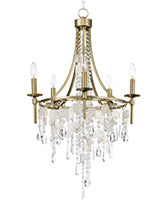
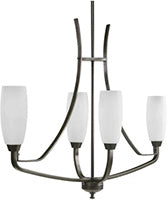
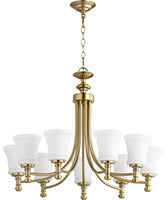
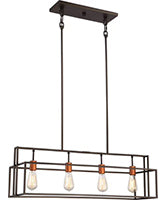
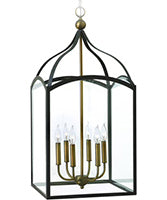
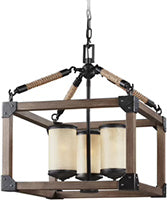

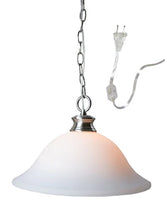
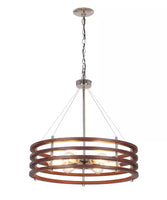



If you've found that your room isn't tall enough, the tabletop is too close to the ceiling, or you just need too much headroom for people to walk, then consider semi-flush mount or flush-mounted lighting. A semi-flush is a little taller than a flush-mount with a small gap between the main light fixture and the ceiling, while a flush-mount light sits snug against the ceiling for minimal height.
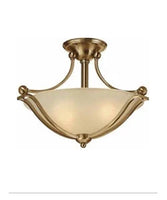

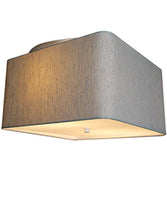
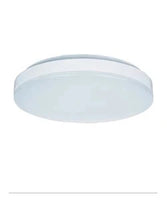
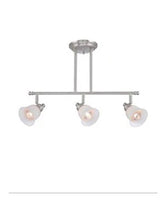

As another alternative to chandeliers and pendants, consider a plug-in light fixture such as a swag pendant. These can be positioned anywhere in the room, are easy to install without an electrician, and simply plug into an electrical outlet. Plug-in wall sconces are also available, along with a wide range of wall sconce lights to complement your ceiling light fixture and add extra ambience to your room.






Explore Topics





Comments